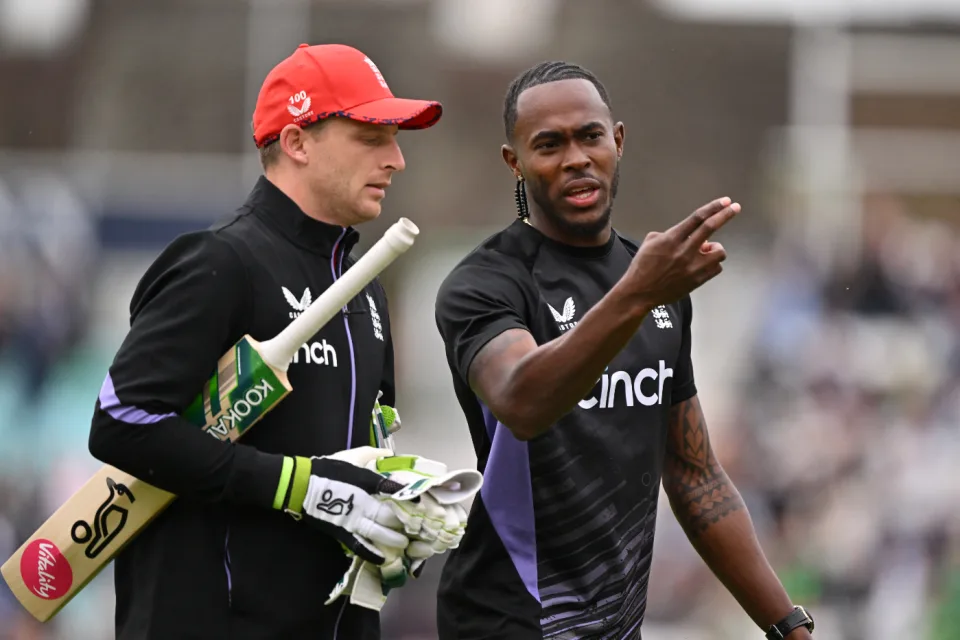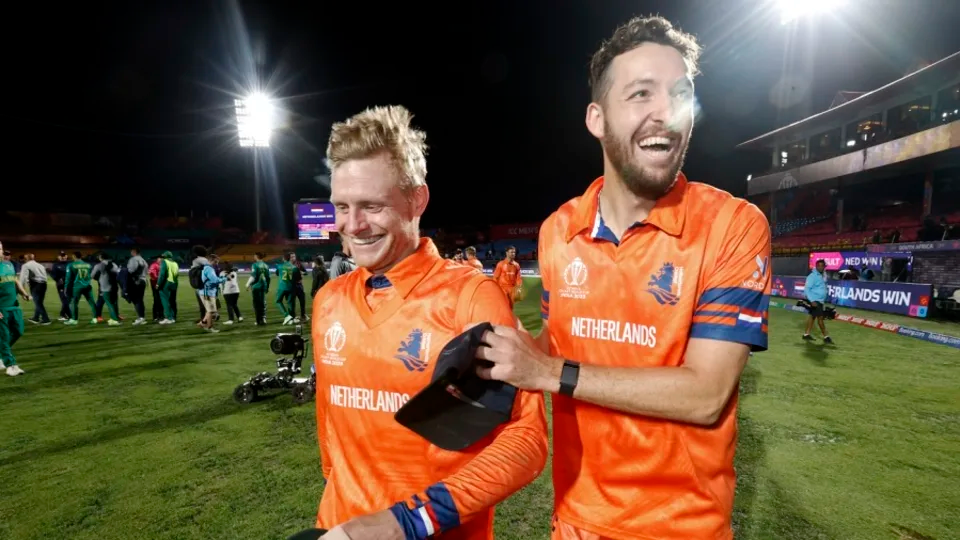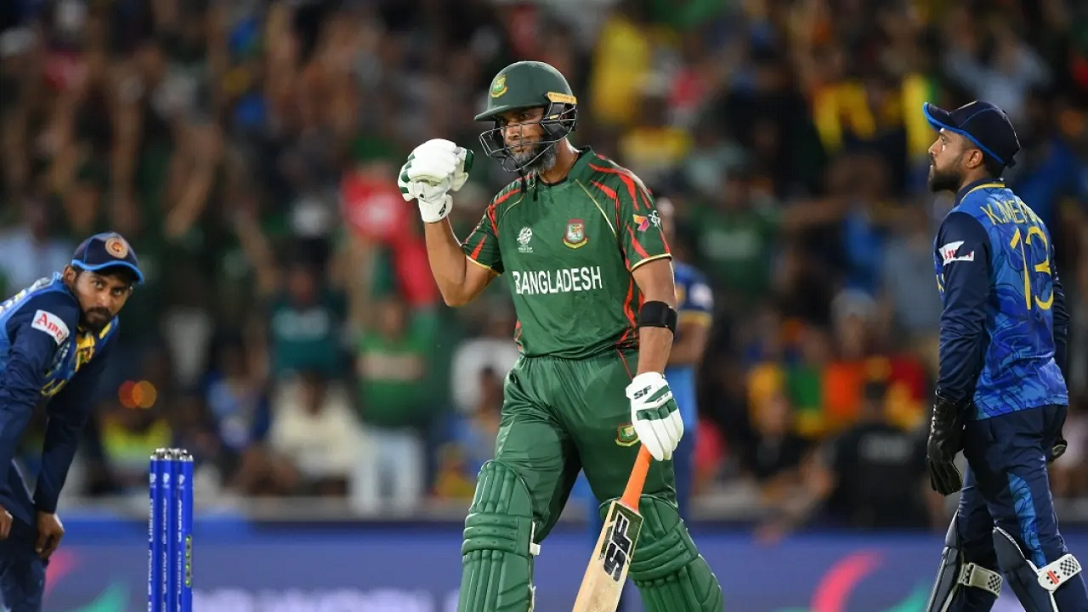Sports
It’s all in the geometry – how Shami and Siraj put the skids under Australia

David Warner came to India with a point to prove. His previous two tours of the country had brought him 388 runs in eight Tests, at an average of 24.25. There were question marks over his game against spin, particularly against his old nemesis R Ashwin.
Warner’s tour has ended, prematurely, and his average in India has dropped further, to 21.78, but while he has struggled against spin, he has only been out to it once in three innings. The larger share of the wounds he is carrying back to Australia – a concussion, a fractured elbow and two dismissals – have been inflicted by India’s fast bowlers.
Mohammed Shami has dismissed Warner twice, both times in a clinical manner that has homed in on an old weakness – a lack of footwork, and consequently a tendency for his bat to come down at an angle while defending good-length balls angling into him from right-arm around.
Both times, Shami homed in on a top-of-off-stump sort of line and length. Both times, he pinned Warner to the crease. In Nagpur, the ball kept going with the angle into Warner, more or less, and bowled him off the thigh pad, beating the inside edge of his bat as it sliced down from gully to mid-on. In Delhi, the ball straightened off the deck, and kissed the outside edge as Warner’s bat sliced across the line in similar manner.
Two classic Shami dismissals, in a classic Shami series. Over the first two Tests, he’s taken seven wickets at an average of 14.42, bowling only 30 overs but taking a wicket every 26 balls.
Mohammed Siraj hasn’t taken a wicket since getting Usman Khawaja lbw with his first ball of the series, but he’s only bowled 18 overs, and has looked extremely awkward to face at times, particularly when he tormented Warner with the short ball in Delhi.
As a combination, India’s quicks have averaged 20.12 over this Border-Gavaskar series. Pat Cummins and Scott Boland, meanwhile, have combined to average 51.00.
Two Tests is a small sample size, of course, and batters have achieved fairly similar control percentages against Shami (79.0), Siraj (80.6), Cummins (80.6) and Boland (81.4), suggesting that there may be a degree of randomness to the skewed averages.
But the skewed averages have been par for course in nearly every home series India have played over the last decade. It’s one thing to induce uncertainty, and another to translate uncertainty into wicket-taking opportunities.
In five of India’s last seven home series, their fast bowlers have collectively averaged below 21. In each of those five series, the opposition quicks have averaged over 35.
How they have done it is partly down to home advantage, and of bowling in a style that heightens their threat on lower-bounce pitches. Shami (20.63), Siraj (22.85), Jasprit Bumrah (15.64) and Umesh Yadav (24.71) all average below 25 at home since the start of 2013. Skiddiness, in one way or another, defines all of them.
What exactly do we mean when we call a fast bowler skiddy? There’s more to it, but at the simplest level it’s all about geometry. Shami, by definition, releases the ball at a significantly shallower angle than the 6’5″ Cummins does to hit the same spot on the pitch. The ball comes off the pitch at a shallower angle too, which means Shami can threaten the stumps from a wider range of lengths than Cummins. It’s why batters are so often rooted to the crease by Shami deliveries that uproot their stumps.
In South Africa last year, the uniformly skiddy nature of India’s pace attack became a disadvantage on pitches where the ball that climbed from a length was the biggest threat to batters. Catches at gully and short leg were likelier occurrences than bowled and lbw, and South Africa’s quicks put their considerable height advantage to telling use to engineer Test wins in Johannesburg and Cape Town.
Tall, hit-the-deck quicks tend to prosper in bouncier conditions, and Australia and South Africa have always had an abundant supply of that sort of bowler. India haven’t always had an assembly line churning out world-class skiddy fast bowlers, but they have had one over the last decade.
India’s skiddiness advantage is most apparent in how well their fast bowlers attack the stumps: 139 of their 253 wickets in home Tests since the start of 2013 have been bowled or lbw. That’s nearly 55%. Visiting teams’ fast bowlers have taken 237 wickets, out of which only 93 – or 39% – have been bowled or lbw.
But skiddiness is also awkward to face from shorter lengths. The short ball comes off the pitch quicker and at a lower height than expected, and tends to cramp the batter for room. When Siraj hit Warner on the elbow and the head in Delhi, it was evident that he had tried to play the pull both times with his elbows tucked in rather than with a full extension of the arms.
Putting batters in these sorts of positions can create genuine wicket-taking chances. Since the start of 2013, according to ESPNcricinfo’s data, India’s fast bowlers have taken 75 wickets from short and short-of-good-length balls in home Tests, at an average of 22.49. In the same time, visiting quicks have taken 71 wickets from these lengths while averaging 40.73.
In Indian conditions, fast bowlers usually only operate in short bursts, whether the ball is new or old. This can be a mixed blessing. You can bowl flat-out, knowing that the spinners will be back soon to take over the workload, but you also know you have a limited window to make an impact in. It takes an incredible amount of skill and intelligence to create chances over these short bursts. Zaheer Khan did it frequently in his pomp, and over the last decade, his successors have taken it to a new level as a collective.
For the visiting batter, then, there’s no respite. If Ashwin, Jadeja and Axar don’t get you, Shami and Siraj probably will.(cricinfo)
Sports
England face Australia in the battle of champions

The first truly heavyweight clash of this expanded T20 World Cup format comes freighted with both history and subplots. A rematch of the 2010 World T20 final at Kensington Oval, the match pits Jos Buttler’s defending champions – who are aiming to become the first team to retain the trophy – against the Australian winning machine, victors at the 2021 edition and current world title-holders in Test and ODI cricket. And that’s before you throw in the Ashes for afters.
Already there is added pressure on England, after the rain in Bridgetown led to a share of the points in their opener against Scotland (and that having conceded 90 runs from 10 overs without taking a wicket in a tepid bowling display). Lose to their oldest rivals and it will leave their Super 8 prospects open to being waylaid by the perils of net run-rate calculations, or worse.
The Scotland match was the third abandonment in five suffered by England, after a rain-affected home series against Pakistan, which has clearly hampered their readiness for this campaign after almost six months without playing T20 together. It does not take much for a side to click in this format – and England looked in decent shape when they did get on the field against Pakistan – but Buttler will be anxious for things to go their way on Saturday, if only to avoid further questions referencing the team’s disastrous ODI World Cup defence last year.
Australia, under the laidback leadership of Mitchell Marsh would love nothing more than to add to the English sense of jeopardy – having helped bundle them out of the tournament in India on the way to taking the crown. Their head to head record is less impressive in T20 however, with England having won six of the last seven completed encounters, as well as that 2010 final.
Despite a wobble with the bat, Australia avoided mishap against Oman earlier in the week, the experience of David Warner and Marcus Stoinis shining through in difficult batting conditions. Surfaces in the Caribbean – not to mention those games staged in the USA – have already had teams scratching their heads; rather than the “slug-fest” England had prepared for, following a high-scoring tour of the Caribbean in December, it looks as if boxing smart may be the way to go.
Speaking of Warner, this could be the last time he faces up against England in national colours – and another match-winning contribution would likely reduce the chances of them meeting again in the knockouts. On the other side of the card is Jofra Archer, fresh from an emotional maiden outing at Kensington Oval and ready to take on Australia for the first time in any format since 2020. Can Mark Wood fire up England’s campaign, as he did during last summer’s Ashes? Will Pat Cummins be back to harass the old enemy once again? Seconds out, it’s almost time to rumble.
Cummins is set to return after being rested for the Oman game, which saw Mitchell Starc leave the field with cramp. Starc is understood to be fine and could keep his place – which would likely see Nathan Ellis miss out. Marsh is still not fit to bowl, with Australia likely to continue with the allrounder combination of Stoinis and Maxwell to give them cover.
Australia (probable XI): David Warner, Travis Head, Mitchell Marsh (capt), Glenn Maxwell, Marcus Stoinis, Josh Inglis (wk), Tim David, Pat Cummins, Nathan Ellis/Mitchell Starc, Adam Zampa, Josh Hazlewood
The one change England may consider is Reece Topley coming in for Wood, with the expectation that there will be some rotation among the seamers through the course of the tournament.
England (probable XI): Phil Salt, Jos Buttler (capt & wk), Will Jacks, Jonny Bairstow, Harry Brook, Liam Livingstone, Moeen Ali, Chris Jordan, Jofra Archer, Adil Rashid, Reece Topley/Mark Wood
[Cricinfo]
Sports
South Africa up against their bogey team in batter-unfriendly New York

Once is coincidence, twice is a clue, and three times is proof.
To paraphrase Agatha Christie, that is the narrative around South Africa’s meeting with Netherlands at this T20 World Cup.
The Dutch beat South Africa at the 2022 tournament and ended their semi-final hopes in a match where South Africa appeared to be sleep walking, and then beat them again at the 2023 ODI World Cup, where they exposed South Africa’s vulnerability in the chase. If they to do the treble, not only will Netherlands take the lead in Group D, but they will offer conclusive evidence of the threat they pose to Full Members, especially South Africa.
Of course, it will take some doing after South Africa’s opening performance against Sri Lanka, where they reduced their opposition to their lowest T20I total and chased it down in fairly straightforward fashion thanks to the most stable middle-order of their white-ball era. In Aiden Markram, Tristan Stubbs, Heinrich Klaasen and David Miller, South Africa have bankers and big-hitters and, for this match, they also have the advantage of experience. They’ve already played at Eisenhower Park, and have first-hand knowledge that run-scoring doesn’t come easily;Klassen said they are prepared to use their “cricket brains” and play “smarter cricket”.
But the conditions could be good news for Netherlands, who are not naturally a line-up of big hitters and build their innings on a foundation of turning ones into twos. In other words, they tend to take a slightly more conservative approach to batting, which may work well here, but they’ll be wary of the uneven bounce of the surface and will have to come up with plans to counterattack especially against South Africa’s seamers. Their own bowlers were exemplary in Dallas and will look to build on that performance against a line-up that will likely be more proactive than Nepal’s, but who they have managed to keep quiet not once, but twice in the past. Third time’s the charm, they say.
Anrich Nortje’s stunning return to form against Sri Lanka means South Africa may not have to tinker with the bowling combination, and Gerald Coetzee and Tabraiz Shamsi may have to wait their turns to get a game. The batting line-up should be unchanged, with no space for Ryan Rickelton yet.
South Africa: Quinton de Kock (wk), Reeza Hendricks, Aiden Markam, Tristan Stubbs, Heinrich Klaasen (wk), David Miller, Marco Jansen, Keshav Maharaj, Kagiso Rabada, Ottneil Baartman, Anrich Nortje
Conditions in New York may tempt Netherlands to include an extra seamer and they have Kyle Klein in their squad. But it could come at the expense of a shortened batting line-up and they may not want to risk that.
Netherlands: Michael Levitt, Max O’Dowd, Vikramjit Singh, Sybrand Engelbrecht, Scott Edwards (capt, wk), Bas de Leede, Teja Nidamanuru, Logan van Beek, Tim Pringle, Paul van Meekeren, Vivian Kingma
[Cricinfo]
Latest News
Mustafizur, Rishad, Hridoy dazzle in Bangladesh’s tight two-wicket win over Sri Lanka

Nuwan Thushara’s last over brought Sri Lanka screaming back into the match,as he first bowled Rishad Hossain, and then nailed Taskin Ahmed in front of the stumps with a pinpoint swinging yorker. This left Bangladesh eight wickets down, with 12 runs still to get.
However, the experienced Mahmudullah was at the crease for Bangladesh, and despite some further nervy moments, pushed Bangladesh across the line off the last ball of the 19th over.
But this was a match chiefly decided by Bangladesh’s own outstanding bowling. Mustafizur Rahman was the best among them, using shorter lengths and his cutters efficiently, to claim figures of 3 for 17. Rishad Hossain’s three-for through the middle overs also kept Sri Lanka quiet.
Mustafizur was instrumental in Sri Lanka’s downward spiral through the middle overs, which culminated in a crash-and-burn end. Ultimately, their inability to find boundaries, or even rotate strike against good Bangladesh bowling resulted in their downfall. A score of 125 for 9 always seemed poor on a decent pitch, even if their bowlers made a match of it in the end.
Brief scores:
Bangladesh 125 for 8 in 19 overs (Towhid Hridoy 40, Litton Das 36; Dhanajaya de Silva 1-11, Nuwan Thushara 4-18, Wanidu Hasaranga 2-32, Matheesha Pathirana 1-27) beat Sri Lanka124 for 9 in 20 overs (Pathum Nissanka 47, Dhananjaya de Silva 21; Tanzim Hasan Sakib 1-24, Taskin Ahmed 2-25, Mustafizur Rahman 3-17, Rishad Hossain 3-22) by two wickets
[Cricinfo]












